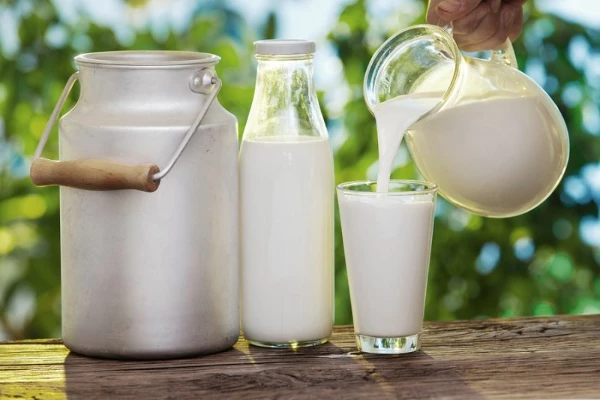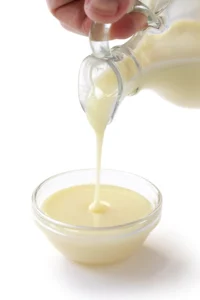
Apr 19, 2025
IndexBox has just published a new report: EU – Whole Fresh Milk – Market Analysis, Forecast, Size, Trends and Insights.
The European Union’s whole fresh milk market is expected to see continued growth in consumption, with a forecasted CAGR of +0.5% in volume and +2.2% in value from 2024 to 2035. This upward trend is projected to bring the market volume to 169M tons and the market value to $125.7B by the end of 2035.
Market Forecast
Driven by increasing demand for whole fresh milk in the European Union, the market is expected to continue an upward consumption trend over the next decade. Market performance is forecast to retain its current trend pattern, expanding with an anticipated CAGR of +0.5% for the period from 2024 to 2035, which is projected to bring the market volume to 169M tons by the end of 2035.
In value terms, the market is forecast to increase with an anticipated CAGR of +2.2% for the period from 2024 to 2035, which is projected to bring the market value to $125.7B (in nominal wholesale prices) by the end of 2035.

Consumption
European Union’s Consumption of Whole Fresh Milk
In 2024, after two years of growth, there was decline in consumption of whole fresh milk, when its volume decreased by -0.1% to 161M tons. The total consumption volume increased at an average annual rate of +1.0% over the period from 2013 to 2024; the trend pattern remained relatively stable, with somewhat noticeable fluctuations being recorded throughout the analyzed period. Over the period under review, consumption hit record highs at 161M tons in 2023, and then declined modestly in the following year.
The size of the whole fresh milk market in the European Union expanded modestly to $99.1B in 2024, surging by 2% against the previous year. This figure reflects the total revenues of producers and importers (excluding logistics costs, retail marketing costs, and retailers’ margins, which will be included in the final consumer price). The market value increased at an average annual rate of +1.1% from 2013 to 2024; the trend pattern remained relatively stable, with somewhat noticeable fluctuations throughout the analyzed period. The pace of growth appeared the most rapid in 2022 when the market value increased by 8.9% against the previous year. As a result, consumption attained the peak level of $101.1B. From 2023 to 2024, the growth of the market remained at a somewhat lower figure.
Consumption By Country
The countries with the highest volumes of consumption in 2024 were Germany (35M tons), France (25M tons) and the Netherlands (15M tons), with a combined 47% share of total consumption. Poland, Italy, Ireland, Spain, Denmark, Belgium and Romania lagged somewhat behind, together comprising a further 39%.
From 2013 to 2024, the most notable rate of growth in terms of consumption, amongst the main consuming countries, was attained by Ireland (with a CAGR of +4.7%), while consumption for the other leaders experienced more modest paces of growth.
In value terms, the largest whole fresh milk markets in the European Union were Germany ($20.1B), France ($15.7B) and the Netherlands ($9.8B), together accounting for 46% of the total market. Italy, Poland, Spain, Ireland, Denmark, Romania and Belgium lagged somewhat behind, together accounting for a further 39%.
Ireland, with a CAGR of +5.5%, saw the highest rates of growth with regard to market size in terms of the main consuming countries over the period under review, while market for the other leaders experienced more modest paces of growth.
In 2024, the highest levels of whole fresh milk per capita consumption was registered in Ireland (1,849 kg per person), followed by Denmark (920 kg per person), the Netherlands (880 kg per person) and Germany (418 kg per person), while the world average per capita consumption of whole fresh milk was estimated at 360 kg per person.
From 2013 to 2024, the average annual rate of growth in terms of the whole fresh milk per capita consumption in Ireland stood at +3.7%. In the other countries, the average annual rates were as follows: Denmark (+0.4% per year) and the Netherlands (+1.6% per year).
Production
European Union’s Production of Whole Fresh Milk
In 2024, after two years of growth, there was decline in production of whole fresh milk, when its volume decreased by -0.3% to 160M tons. The total output volume increased at an average annual rate of +1.0% from 2013 to 2024; the trend pattern remained relatively stable, with only minor fluctuations throughout the analyzed period. The growth pace was the most rapid in 2014 with an increase of 3.5%. The volume of production peaked at 161M tons in 2023, and then contracted modestly in the following year. The general positive trend in terms output was largely conditioned by a slight expansion of the number of producing animals and a modest increase in yield figures.
In value terms, whole fresh milk production rose modestly to $100.1B in 2024 estimated in export price. The total output value increased at an average annual rate of +1.0% over the period from 2013 to 2024; the trend pattern remained relatively stable, with only minor fluctuations throughout the analyzed period. The pace of growth appeared the most rapid in 2022 when the production volume increased by 9.9%. As a result, production attained the peak level of $102.4B. From 2023 to 2024, production growth remained at a somewhat lower figure.
Production By Country
The countries with the highest volumes of production in 2024 were Germany (33M tons), France (25M tons) and Poland (15M tons), together comprising 46% of total production. The Netherlands, Italy, Ireland, Spain, Denmark, Belgium and Romania lagged somewhat behind, together accounting for a further 38%.
From 2013 to 2024, the most notable rate of growth in terms of production, amongst the leading producing countries, was attained by Ireland (with a CAGR of +4.4%), while production for the other leaders experienced more modest paces of growth.
Yield
In 2024, the average whole fresh milk yield in the European Union reduced to 3.1 tons per head, with a decrease of -2.1% on the previous year’s figure. The yield figure increased at an average annual rate of +1.8% from 2013 to 2024; the trend pattern remained consistent, with somewhat noticeable fluctuations being recorded throughout the analyzed period. The pace of growth appeared the most rapid in 2014 when the yield increased by 6.2% against the previous year. The level of yield peaked at 3.2 tons per head in 2023, and then contracted slightly in the following year.
Producing Animals
The global number of animals for whole fresh milk production totaled 51M heads in 2024, picking up by 1.9% compared with the previous year. Overall, the number of producing animals, however, recorded a relatively flat trend pattern. The most prominent rate of growth was recorded in 2018 with an increase of 3.1% against the previous year. The level of producing animals peaked at 56M heads in 2013; however, from 2014 to 2024, producing animals failed to regain momentum.
Imports
European Union’s Imports of Whole Fresh Milk
In 2024, overseas purchases of whole fresh milk decreased by -0.4% to 7.9M tons for the first time since 2021, thus ending a two-year rising trend. The total import volume increased at an average annual rate of +1.0% over the period from 2013 to 2024; the trend pattern remained consistent, with somewhat noticeable fluctuations being recorded in certain years. The most prominent rate of growth was recorded in 2022 when imports increased by 13% against the previous year. Over the period under review, imports reached the peak figure at 8.4M tons in 2017; however, from 2018 to 2024, imports stood at a somewhat lower figure.
In value terms, whole fresh milk imports fell slightly to $4.6B in 2024. Total imports indicated modest growth from 2013 to 2024: its value increased at an average annual rate of +1.1% over the last eleven years. The trend pattern, however, indicated some noticeable fluctuations being recorded throughout the analyzed period. Based on 2024 figures, imports increased by +46.1% against 2019 indices. The growth pace was the most rapid in 2022 with an increase of 32%. The level of import peaked at $4.7B in 2023, and then shrank slightly in the following year.
Imports By Country
Germany was the largest importer of whole fresh milk in the European Union, with the volume of imports finishing at 2.7M tons, which was near 34% of total imports in 2024. The Netherlands (931K tons) ranks second in terms of the total imports with a 12% share, followed by Belgium (12%), Italy (9.2%), Ireland (8.4%) and Lithuania (6.9%). Croatia (216K tons) followed a long way behind the leaders.
From 2013 to 2024, average annual rates of growth with regard to whole fresh milk imports into Germany stood at +5.4%. At the same time, Ireland (+7.0%), the Netherlands (+5.9%), Croatia (+3.8%), Lithuania (+2.6%) and Belgium (+1.2%) displayed positive paces of growth. Moreover, Ireland emerged as the fastest-growing importer imported in the European Union, with a CAGR of +7.0% from 2013-2024. By contrast, Italy (-7.5%) illustrated a downward trend over the same period. From 2013 to 2024, the share of Germany, the Netherlands and Ireland increased by +13, +4.8 and +3.9 percentage points, respectively. The shares of the other countries remained relatively stable throughout the analyzed period.
In value terms, Germany ($1.5B) constitutes the largest market for imported whole fresh milk in the European Union, comprising 33% of total imports. The second position in the ranking was held by the Netherlands ($558M), with a 12% share of total imports. It was followed by Belgium, with a 9.5% share.
In Germany, whole fresh milk imports expanded at an average annual rate of +6.3% over the period from 2013-2024. The remaining importing countries recorded the following average annual rates of imports growth: the Netherlands (+5.1% per year) and Belgium (-0.3% per year).
Import Prices By Country
The import price in the European Union stood at $583 per ton in 2024, falling by -2.1% against the previous year. Overall, the import price, however, recorded a relatively flat trend pattern. The pace of growth was the most pronounced in 2017 an increase of 21%. The level of import peaked at $595 per ton in 2023, and then fell in the following year.
Average prices varied somewhat amongst the major importing countries. In 2024, major importing countries recorded the following prices: in the Netherlands ($599 per ton) and Italy ($591 per ton), while Belgium ($478 per ton) and Lithuania ($515 per ton) were amongst the lowest.
From 2013 to 2024, the most notable rate of growth in terms of prices was attained by Germany (+0.9%), while the other leaders experienced mixed trends in the import price figures.
Exports
European Union’s Exports of Whole Fresh Milk
In 2024, whole fresh milk exports in the European Union dropped modestly to 7.8M tons, waning by -3.5% compared with the previous year. Overall, exports, however, saw a relatively flat trend pattern. The growth pace was the most rapid in 2014 when exports increased by 7.8%. The volume of export peaked at 8.1M tons in 2015; however, from 2016 to 2024, the exports stood at a somewhat lower figure.
In value terms, whole fresh milk exports reduced slightly to $4.8B in 2024. In general, exports, however, continue to indicate a relatively flat trend pattern. The most prominent rate of growth was recorded in 2017 with an increase of 17% against the previous year. The level of export peaked at $5B in 2023, and then dropped slightly in the following year.
Exports By Country
In 2024, Germany (1.4M tons), followed by Belgium (918K tons), the Czech Republic (912K tons), Poland (740K tons), the Netherlands (505K tons), Austria (434K tons), France (431K tons) and Latvia (356K tons) were the largest exporters of whole fresh milk, together committing 73% of total exports. The following exporters – Hungary (287K tons) and Slovenia (283K tons) – each finished at a 7.3% share of total exports.
From 2013 to 2024, the most notable rate of growth in terms of shipments, amongst the main exporting countries, was attained by Poland (with a CAGR of +12.8%), while the other leaders experienced more modest paces of growth.
In value terms, the largest whole fresh milk supplying countries in the European Union were Germany ($899M), Belgium ($553M) and the Czech Republic ($515M), with a combined 41% share of total exports. Poland, the Netherlands, Austria, France, Latvia, Slovenia and Hungary lagged somewhat behind, together accounting for a further 40%.
Among the main exporting countries, Poland, with a CAGR of +13.9%, saw the highest rates of growth with regard to the value of exports, over the period under review, while shipments for the other leaders experienced more modest paces of growth.
Export Prices By Country
The export price in the European Union stood at $618 per ton in 2024, leveling off at the previous year. Over the period under review, the export price, however, showed a relatively flat trend pattern. The pace of growth was the most pronounced in 2017 an increase of 20%. The level of export peaked at $622 per ton in 2023, and then shrank modestly in the following year.
Prices varied noticeably by country of origin: amid the top suppliers, the country with the highest price was Austria ($746 per ton), while Latvia ($489 per ton) was amongst the lowest.
From 2013 to 2024, the most notable rate of growth in terms of prices was attained by Austria (+1.7%), while the other leaders experienced more modest paces of growth.





